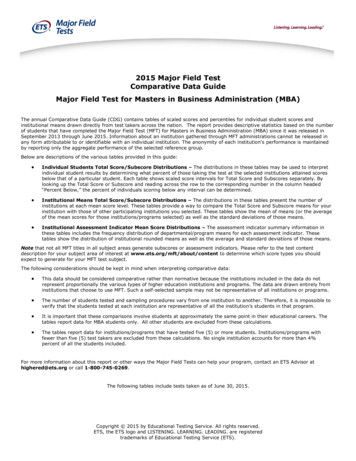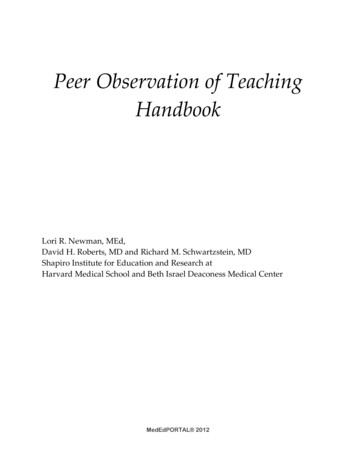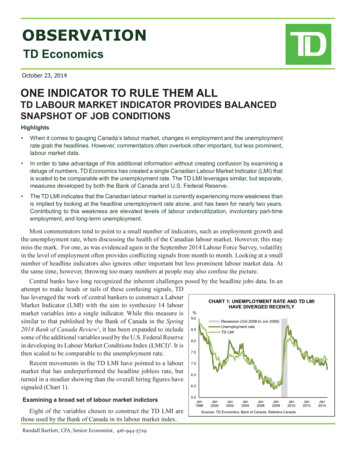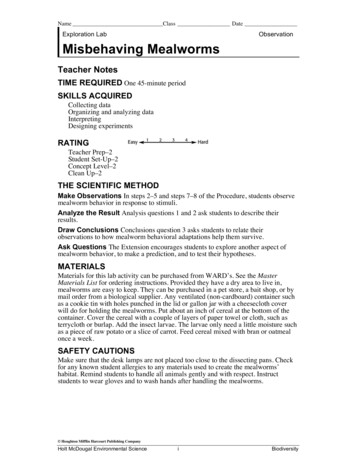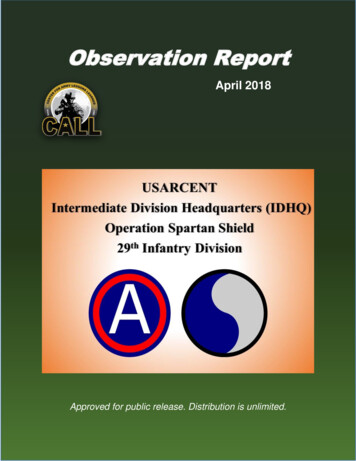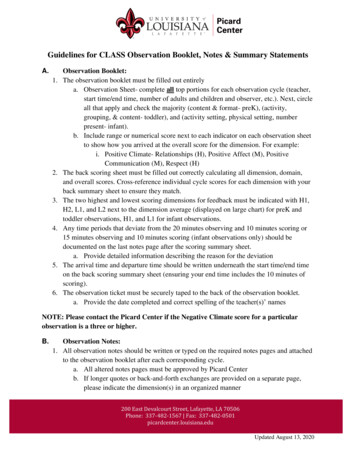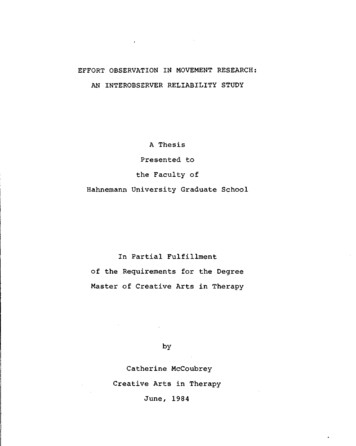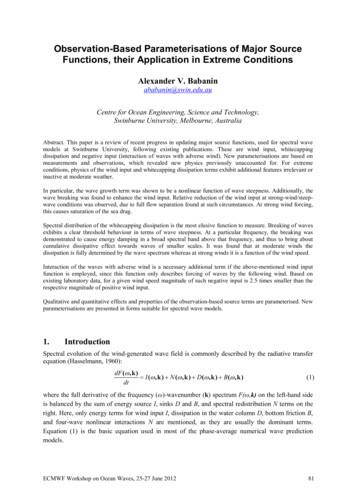
Transcription
Observation-Based Parameterisations of Major SourceFunctions, their Application in Extreme ConditionsAlexander V. Babaninababanin@swin.edu.auCentre for Ocean Engineering, Science and Technology,Swinburne University, Melbourne, AustraliaAbstract. This paper is a review of recent progress in updating major source functions, used for spectral wavemodels at Swinburne University, following existing publications. These are wind input, whitecappingdissipation and negative input (interaction of waves with adverse wind). New parameterisations are based onmeasurements and observations, which revealed new physics previously unaccounted for. For extremeconditions, physics of the wind input and whitecapping dissipation terms exhibit additional features irrelevant orinactive at moderate weather.In particular, the wave growth term was shown to be a nonlinear function of wave steepness. Additionally, thewave breaking was found to enhance the wind input. Relative reduction of the wind input at strong-wind/steepwave conditions was observed, due to full flow separation found at such circumstances. At strong wind forcing,this causes saturation of the sea drag.Spectral distribution of the whitecapping dissipation is the most elusive function to measure. Breaking of wavesexhibits a clear threshold behaviour in terms of wave steepness. At a particular frequency, the breaking wasdemonstrated to cause energy damping in a broad spectral band above that frequency, and thus to bring aboutcumulative dissipative effect towards waves of smaller scales. It was found that at moderate winds thedissipation is fully determined by the wave spectrum whereas at strong winds it is a function of the wind speed.Interaction of the waves with adverse wind is a necessary additional term if the above-mentioned wind inputfunction is employed, since this function only describes forcing of waves by the following wind. Based onexisting laboratory data, for a given wind speed magnitude of such negative input is 2.5 times smaller than therespective magnitude of positive wind input.Qualitative and quantitative effects and properties of the observation-based source terms are parameterised. Newparameterisations are presented in forms suitable for spectral wave models.1.IntroductionSpectral evolution of the wind-generated wave field is commonly described by the radiative transferequation (Hasselmann, 1960):dF (ω ,k) I (ω ,k) N (ω ,k) D(ω ,k) B(ω ,k)dt(1)where the full derivative of the frequency (ω)-wavenumber (k) spectrum F(ω,k) on the left-hand sideis balanced by the sum of energy source I, sinks D and B, and spectral redistribution N terms on theright. Here, only energy terms for wind input I, dissipation in the water column D, bottom friction B,and four-wave nonlinear interactions N are mentioned, as they are usually the dominant terms.Equation (1) is the basic equation used in most of the phase-average numerical wave predictionmodels.ECMWF Workshop on Ocean Waves, 25-27 June 201281
BABANIN, A.V: OBSERVATION BASED SOURCE FUNCTIONSUntil the last decade, experimental knowledge of the major source functions for wave models wasvery fragmental. They were largely based on theoretical argument combined with extensive tuning(e.g. Komen et al., 1994). Even when experimental data were available, these were either laboratorydata or field measurements and observations conducted at light-to-moderate wind forcing, whoseparameterisations are then extrapolated if extreme conditions are to be modelled. Such extrapolationsare questionable, since physics of air-sea interaction at strong winds is expected and is known to bedifferent (e.g. Babanin, 2011a,b).In absence of reliable measurements of source functions, validations concentrated on reproducingwave growth curves. These are known reasonably well experimentally, and starting from seminal fieldobservations of Mitsuyasu (1971) and JONSWAP (Hasselmann et al., 1973) their knowledge hascontinued to improve. The problem with such verifications, however, is that contributions of differentsource functions cannot be evaluated separately. What is validated is the balance of source terms in(1), while individual terms can be well of the scale (Babanin et al., 2010, Tsagareli et al., 2010).Potentially, this could lead to model failures or inaccuracy in conditions where such balance differsfrom the tuned situations.Over the last decade, experimental knowledge of the source functions have improved significantly(e.g. The WISE Group, 2007), and this both produced quantitative guidance for the magnitude andparameterisations of the energy inputs/sinks and revealed new qualitative features of their behaviouras will be described in some detail in subsequent Sections. It is only recently, however, that the newknowledge and new physics started to make its way into the spectral models (Donelan, 2001, Babaninet al., 2007a, 2010, Ardhuin et al., 2010, Filipot et al., 2010, Tsagareli et al., 2010) and even inoperational forecasting (Ardhuin et al., 2010, Tolman et al., 2011, Zieger et al., 2011, Donelan et al.,2012, Rogers et al., 2012).Attention to the experimentally-guided physics also brings about the need for testing and calibratingthe source functions independently, based on physical constraints (Babanin et al., 2005, 2007a, 2010,Tsagareli et al., 2010, Rogers et al., 2012). If each function satisfies respective constraints, then oncecombined in a wave-forecast model they require little or no further tuning to satisfy the academicgrowth tests or real ocean-wave hindcasts (Zieger et al., 2011, Rogers et al., 2012).The present paper is not a general analysis of the problem and of the state of the art of the wavemodelling. It is rather a review of observation-based source functions developed or adopted at theCentre of Ocean Engineering, Science and Technology of Swinburne University for spectralmodelling, in collaboration with colleagues from Australia and overseas. In this regard, we shouldseparate the experimentally observed phenomena of the energy/momentum exchanges in the windwave-ocean system and their parameterisations. The parameterisations, i.e. mathematical expressionsfor the source terms employed by the models, can differ between the models or model versions, untilexplicit theoretical description of the processes become available, but they all have to accommodateexperimentally observed characteristics of these physical terms, in order for the models to conformclosely with physical reality. For example, formulations for the new whitecapping dissipation terms inYoung and Babanin (2006) and in Ardhuin et al. (2010) are different, but they both contain theimportant new features of the threshold behaviour for dissipation due to wave breaking and of thecumulative dissipation at small scales in the spectrum, and in this respect both source terms areconsistent with observations.82ECMWF Workshop on Ocean Waves, 25-27 June 2012
BABANIN, A.V: OBSERVATION BASED SOURCE FUNCTIONSThe source functions discussed here are the wind input, whitecapping dissipation and negative input(interaction of waves with adverse wind). The first two are obtained in the course of Lake Georgefield experiment (Young et al., 2005). Negative input is introduced according to laboratoryexperiments of Donelan (1999) with the following and adverse winds.2.The observation-based source functionsThe Lake George field experiment was designed to study the spectral balance of the source terms forwind-generated waves in finite water depth (Fig. 1). The measurements were made from a shoreconnected platform at varying water depths from 1.2 m down to 20 cm. Wind conditions and thegeometry of the lake were such that fetch-limited conditions with fetches ranging from approximately10 km down to 1 km prevailed. The resulting waves were intermediate-depth wind waves with inversewave ages, measured by the ratio of wind speed at 10 m height above the sea level, U 10 to the phasespeed of the dominant (spectral peak) waves, c p in the range of 1 U 10 / c p 8 . The range is verybroad and includes extreme wind forcing at the upper end.The atmospheric input, whitecap dissipation and bottom friction were measured directly andsynchronously by an integrated measurement system (Young et al., 2005). In addition, simultaneousdata on the directional wave spectrum, atmospheric boundary-layer profile and atmospheric andunderwater turbulence were acquired. The contribution to the spectral evolution due to nonlinearinteractions of various orders was investigated by a combination of bi-spectral analysis of the data andnumerical modelling. The relatively small scale of the lake enabled experimental conditions such asthe wind field and bathymetry to be well defined. The observations were conducted over a three-yearperiod from September, 1997 to August, 2000, with a designated intensive measurement period(AUSWEX) carried out in August-September 1999. High data return was achieved (Young et al.,2005).Figure 1. Location and view of the Lake George experimental site.2.1.Wind inputMeasurements of the wind input energy source I in (1) and its subsequent parameterisation as afunction of wave spectrum and environmental forcing are described in a three-part series of papers byDonelan et al. (2005, 2006) and Babanin et al. (2007b). Technology of direct field measurements ofthe wave-induced pressure in the air flow over water waves is explained in Donelan et al. (2005).Nearly all of the energy delivered from wind to waves comes about through such wave-inducedECMWF Workshop on Ocean Waves, 25-27 June 201283
BABANIN, A.V: OBSERVATION BASED SOURCE FUNCTIONSpressure acting on the slopes of waves. The measurements of this kind are difficult and consequentlyrare, particularly in the field. In order to measure micro-scale oscillations of the induced pressureabove surface waves, a high-precision wave-follower system was developed at the University ofMiami, Florida and deployed at Lake George (Fig. 2). The principal sensing hardware included Elliottpressure probes, hot-film anemometers and Pitot tubes. The precision of the feedback wave-followingmechanism did not impose any restrictions on the measurement accuracy in the range of wave heightsand frequencies relevant to the problem. Thorough calibrations of the pressure transducers andmoving Elliott probes were conducted. As a result of this study, it was shown for the first time that theresponse of the air column in the connecting tubes provides a frequency-dependent phase shift. Thiseffect was not accounted for in previous measurements of this kind, but is very important forrecovering the low-level induced pressure signal, particularly at higher frequencies.Figure 2. The wave follower shown positioned on the measurement bridge during AUSWEX.Three fingers with pressure probes can be seen on the shaft: the Elliott probe is at the bottom,with hot film anemometer above and the Pitot tube at the top.The dimensionless growth rate of waves due to wind is often expressed in terms of the fractionalenergy increase γ, which is a spectral functionγ (ω ) ρ w 1 F (ω ).ρ a ω F (ω ) t(2)Here, ρ w and ρ a are densities of the water and air respectively. Once the growth rate function γ (ω ) isknown and the power spectrum F(ω) is available, the dimensional wind energy input isI (ω ) ρ aω gγ (ω ) F (ω )(3)where g is the gravitational constant.Function for γ(ω), therefore, is the main experimental or theoretical task of the wind-inputparameterisations. Note that γ(ω) is a spectral function, but is usually perceived not depending on thewave spectrum, i.e. the wind input spectrum I(ω) is a linear function of F(ω).γ(ω) apparently depends on wind forcing, which is introduced through ratio of wind speed to phasespeed of the wave c(ω). As the wind-speed proxy, either speed at a particular elevation above the84ECMWF Workshop on Ocean Waves, 25-27 June 2012
BABANIN, A.V: OBSERVATION BASED SOURCE FUNCTIONSmean water level is used (for example, U 10 or U λ / 2 , the wind speed at the height of half of thewavelength λ), or friction velocity u* . The friction velocity has dimension of speed, but is not a windspeed as such, it is a characteristic of wind stress (total momentum flux) τ:2 τ ρ ρ a CdU102a u*(4)Here, Cd is the so called drag coefficient, an empirical property intended to convert the mean windspeed, usually available, into the momentum flux which is difficult to measure. Expression (4) impliessome kind of proportionality between U 10 and u* , but in reality Cd is a growing function of the windspeed itself. Overall, it represents a complex structure of the atmospheric boundary layer and dependson very many features in the air-sea system near interface (e.g. Babanin and Makin, 2008). For thewind-input source term this is particularly essential as parameterisations in terms of U10/c are noteasily convertible into u* / c . Functional form of the former is γ (U10 / c 1)n , and for the latter it isγ ( u* / c ) . This is because the wind input tends to zero when wind speed approaches wave phasenspeed U10 c , whereas for the friction velocity this condition is u* 0 , i.e. momentum fluxbecomes zero.2.1.1.Nonlinear dependence of the wind-wave energy exchange on wave spectrumPreviously reported measurements of the wave-induced air pressure were conducted in deep-water atconditions in which the level of forcing was rather weak: U 10 / c p 3 . As mentioned above, the datareported here, obtained during AUSWEX, have the range of 1 U 10 / c p 8 .At Lake George, the propagation speeds of the dominant waves were limited by depth and, if thewaves reached this limit, they were correspondingly steep. This provided the authors with a variety ofwave slope values usually unavailable for direct observations outside laboratory conditions and thusenabled an investigation of a wave-steepness effect on the wind-wave energy exchange. The wavesteepness is further characterised by product ak where a is the wa
pressure probes, hot-film anemometers and Pitot tubes. The precision of the feedback wave-following mechanism did not impose any restrictions on the measurement accuracy in the range of wave heights and frequencies relevant to the problem. Thorough calibrations of the pressure transducers and moving Elliott probes were conducted. As a result of this study, it was shown for the first time that the
